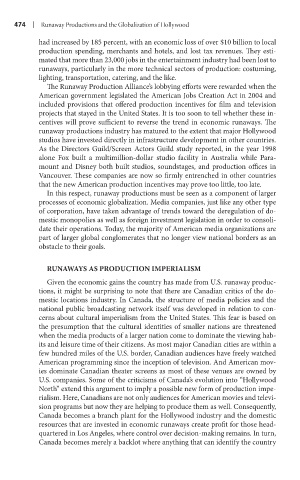Page 495 - Battleground The Media Volume 1 and 2
P. 495
| Runaway Product ons and the Global zat on of Hollywood
had increased by 185 percent, with an economic loss of over $10 billion to local
production spending, merchants and hotels, and lost tax revenues. They esti-
mated that more than 23,000 jobs in the entertainment industry had been lost to
runaways, particularly in the more technical sectors of production: costuming,
lighting, transportation, catering, and the like.
The Runaway Production Alliance’s lobbying efforts were rewarded when the
American government legislated the American Jobs Creation Act in 2004 and
included provisions that offered production incentives for film and television
projects that stayed in the United States. It is too soon to tell whether these in-
centives will prove sufficient to reverse the trend in economic runaways. The
runaway productions industry has matured to the extent that major Hollywood
studios have invested directly in infrastructure development in other countries.
As the Directors Guild/Screen Actors Guild study reported, in the year 1998
alone Fox built a multimillion-dollar studio facility in Australia while Para-
mount and Disney both built studios, soundstages, and production offices in
Vancouver. These companies are now so firmly entrenched in other countries
that the new American production incentives may prove too little, too late.
In this respect, runaway productions must be seen as a component of larger
processes of economic globalization. Media companies, just like any other type
of corporation, have taken advantage of trends toward the deregulation of do-
mestic monopolies as well as foreign investment legislation in order to consoli-
date their operations. Today, the majority of American media organizations are
part of larger global conglomerates that no longer view national borders as an
obstacle to their goals.
runaways as ProDuCTion imPEriaLism
Given the economic gains the country has made from U.S. runaway produc-
tions, it might be surprising to note that there are Canadian critics of the do-
mestic locations industry. In Canada, the structure of media policies and the
national public broadcasting network itself was developed in relation to con-
cerns about cultural imperialism from the United States. This fear is based on
the presumption that the cultural identities of smaller nations are threatened
when the media products of a larger nation come to dominate the viewing hab-
its and leisure time of their citizens. As most major Canadian cities are within a
few hundred miles of the U.S. border, Canadian audiences have freely watched
American programming since the inception of television. And American mov-
ies dominate Canadian theater screens as most of these venues are owned by
U.S. companies. Some of the criticisms of Canada’s evolution into “Hollywood
North” extend this argument to imply a possible new form of production impe-
rialism. Here, Canadians are not only audiences for American movies and televi-
sion programs but now they are helping to produce them as well. Consequently,
Canada becomes a branch plant for the Hollywood industry and the domestic
resources that are invested in economic runaways create profit for those head-
quartered in Los Angeles, where control over decision-making remains. In turn,
Canada becomes merely a backlot where anything that can identify the country

